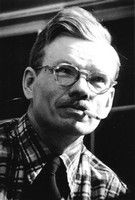Kenneth Stubbs |
 |
Kenneth Stubbs |
 |
|
Expressionists Carry the FieldThe Society of Washington Artists' Sixty-first Annual Exhibition, which opened last week, once again shows the benefits to be derived by an out-of-town jury of exacting standards. The show is small, concise, and of good quality. Of the 636 works submitted, only 98 were chosen by jurists Peppino Mangravite and Hugo Robus for inclusion in the final exhibition. While the quality of even these 98 works is uneven, the standard of competence seems uniformly high throughout. The awards were given to three of Washington's most talented painters: Mimi Dubois Bolton, first prize; Leonard Maurer, second, and Alfred McAdams, third. Mimi Bolton's "City Fabric" is a semiabstract treatment of city buildings and fire escapes, with a deliberately austere color scheme. Maurer's painting is a romantic and evocative treatment of the Greek myth of Orpheus and Eurydice. The canvas is a scintillating play of warm color against cool, with a flickering incandescence in the tones, caused by the fracturing of the light into starlike shapes. Alfred McAdams shows one of his wonderful buildings in a state of partial destruction, with delicate calligraphy overlying the suavely painted forms. All three paintings have an exquisite sensitivity of observation, with a heightened and personal approach. Sculpture prizes went to Frank Yee for his heavily carved figure of a woman; to Barbara Foster for a nice study of a head; to Hazel van Natter for a small, pyramidal composition, and to Oswald Bridge's totemic "Indian's Dream." Rowland Lyon shows a plump and satisfying "Setting Hen"; Guy Sheats a suave twisting of copper tubing, called "Consciousness Emergent from Physical Force." The material seems highly inimical to so metaphysical a subject; the subject far too pretentious for so mechanical a device. There are several formal abstractions of excellent quality in the show, such as Kenneth Stubbs' strong, simple composition, and the handsome study by Don Robertson. Robert Willis shows a vibrant color synthesis, and Frederick Reinig a small semiabstract horror story called "Beyond Time and Space." Peter Blanc's "Conservatory," which received an honorable mention, is one of the best things he has painted: a beautifully integrated study of hanging foliage against geometric shapes. Richard Miller and John Dixon both submit handsome still lifes with an architectural handling of the objects. The Impressionists are well represented. Theodora Kane and Lois Mailou Jones both show colorful and well integrated studies. John Bryans' "Flotsam and Jetsam" is a fine study in textures. Cora Lee Campbell's exquisite little study, "Early Evening," is one of the high spots of the show. The realist school is shown in a little painting by Harry Eisenberg, "Red Wool,' an outstanding example that was sold even before the show opened. But it is the Expressionists--whether objective or abstract--who steal the show. Lazzari's terrifying "Grotesque" with its morbid blood reds; Melvin Buckner's tortured study of three men; Jacob Kainen's surging "Hour of the Beast"; Bent Lane's subtle and strong "Sunset Coast"; Martin Ries' evocative and dreamlike study; Samuel Bookatz' romantic "Tower Clock"; de Burgos' destroyed city; John Chapman Lewis' sensitive treatment of a fishing wharf; Helene McKinsey's beautiful "Summer No 2," and Olga Weiss' "Consolation"--these are the paintings that give the show its punch and vigor. The American artist seems never more completely at home than when painting in a romantic or expressionist manner. The cold dialectics of pure abstraction seem to leave no room for the warm sentimentality of the American spirit; the realist school seems too often to degenerate into a postcard report of externals; the surrealists are too patently derivative of a hyper-sophistication they do not feel. But in the tradition of Ryder and the Hudson River School of romantic landscapists; in the sweepingly frank sentiment of a Walt Whitman or a Thomas Wolfe; in the lingering tones of our folk songs, we seem best to offer what we have, and what we believe in. And in expressionist painting, where the dreams and moods of the artist are given free rein, the American seems to find himself, and to feel once again at home. If there is ever to rise a unified school out of our disparate and often opposing tendencies, it would seem that expressionism, in its traditional, as well as in its contemporary semiabstract and abstract forms, may come the closest to expressing our national character. Leslie Judd Portner, Washington Post, March 15, 1953, page L3
|
See also: Show Catalog |